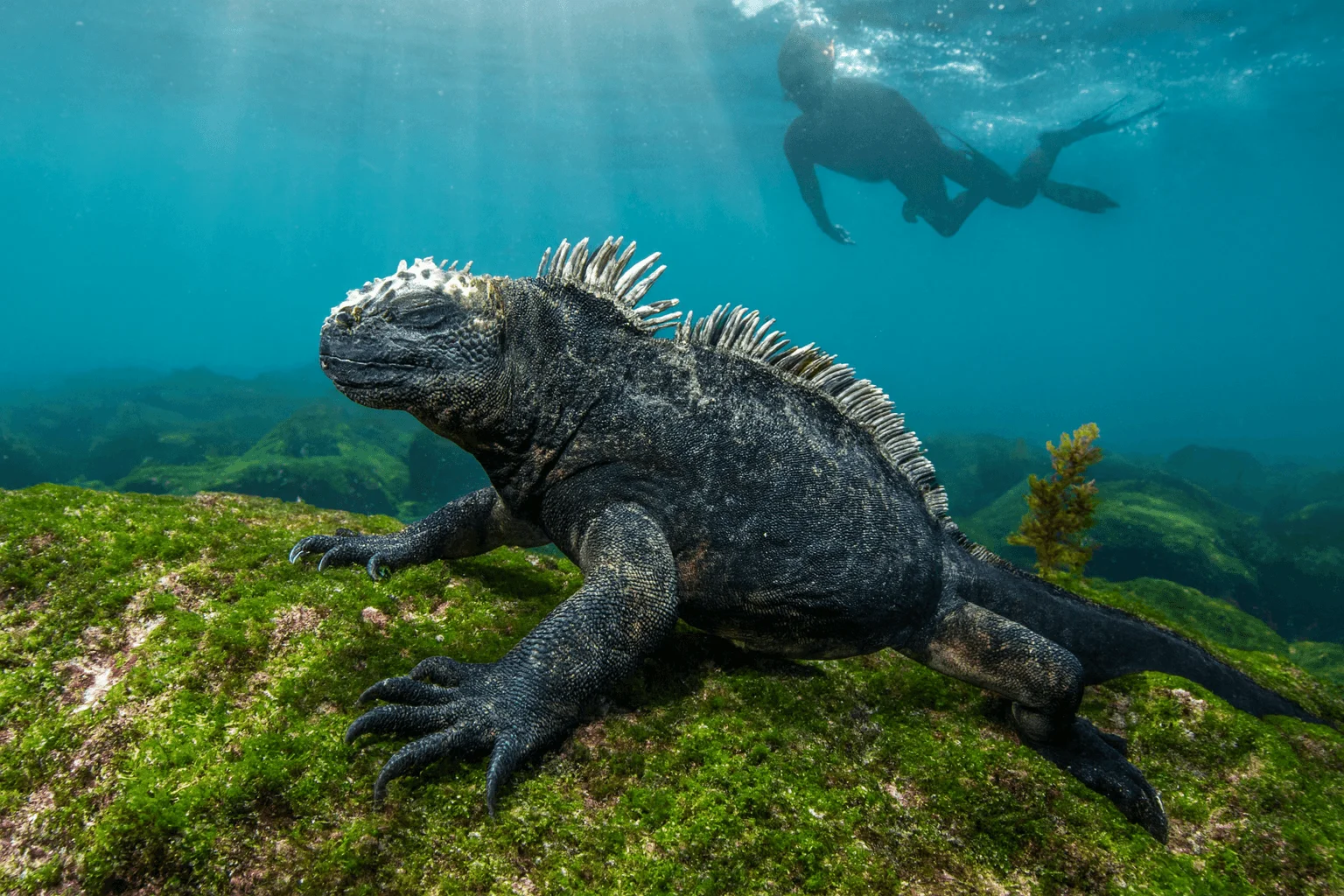Scuba Diving in Galapagos
The Ultimate Guide
The Galápagos Islands sit 1 000 km off mainland Ecuador and are famous for their remarkable biodiversity both above and below the water. Created by volcanic hot spots and washed by the converging Humboldt, Panama and Cromwell currents, these remote islands offer some of the most exhilarating diving on the planet. Liveaboard trips venture north to Darwin and Wolf islands, where swirling schools of scalloped hammerheads and hundreds of silky and Galápagos sharks patrol the drop‑offs. Other sites host oceanic manta rays, whale sharks, dolphins, marine iguanas, penguins and playful sea lions. Strong currents, cool upwellings and surge mean the dives are challenging but incredibly rewarding. On land you can explore lava fields, giant tortoise sanctuaries and blue‑footed booby colonies.
Difficulty
Advanced
Temperature
18–27°C (cooler in upwellings)
Visibility
10–30 m

Diving Highlights
Best Months to Dive
Getting to Galapagos for Diving
✈️Transportation
To reach the Galápagos you must first fly to Ecuador’s mainland hubs of Quito or Guayaquil. From there, domestic flights of 1.5–2 hours depart daily for Baltra (serving Santa Cruz) or San Cristóbal islands.
Visitors must obtain a Transit Control Card (TCT) at the airport and pay the Galápagos National Park entry fee on arrival.
Most dive itineraries are liveaboards embarking from these islands; they often include a couple of shakedown dives near Santa Cruz or San Cristóbal before heading to the remote northern islands of Darwin and Wolf.
Land‑based diving is possible around Santa Cruz and San Cristóbal but misses the marquee sites.
Country
Ecuador
Currency
US Dollar
Electricity
120V, 60Hz,US plug
Cost of a Dive Trip in Galapagos
Liveaboard
Day Trip
Meal
Accommodation
Best Dive Sites in Galapagos
🐠Darwin’s Arch (Pillars of Evolution)
The northernmost site, Darwin’s Arch (now collapsed but still known as the Pillars of Evolution) lies off Darwin Island. Here you drift in medium‑to‑strong currents while watching hundreds of scalloped hammerheads schooling overhead. Whale sharks up to 12 m long cruise past between June and November, while Galápagos and silky sharks dart in and out of the blue. Dolphins and sea turtles are frequent companions.
🐢Wolf Island (Landslide & Shark Bay)
Wolf Island hosts legendary sites like The Landslide and Shark Bay, where huge schools of hammerheads form a wall of sharks. Galápagos sharks, eagle rays, green turtles and bottlenose dolphins add to the spectacle, and between June and November whale sharks often appear in the blue.
🦈Cape Marshall (Isabela Island)
On Isabela’s east coast, Cape Marshall is known as “Manta Ray City.” A shallow plateau drops into a wall where oceanic manta rays, mobulas and sometimes marlins glide past. Schooling hammerheads also visit the cleaning stations along the wall.
🐙Vicente Roca Point (Isabela Island)
At this cold‑upwelling site on Isabela’s northwest tip, nutrient‑rich water attracts mola mola (sunfish), sea lions and Galápagos penguins. The dramatic wall is covered in soft corals and sponges, and sea turtles graze along the slope.
🐚Cape Douglas (Fernandina Island)
On Fernandina Island you can dive with the world’s only marine iguanas. At Cape Douglas they enter the water at midday to graze on algae, sharing the site with flightless cormorants, sea lions and penguins. It’s a surreal experience unlike any other dive on earth.
🦑Cousin’s Rock (Santiago Island)
This volcanic cone off Santiago Island offers a mix of macro and pelagic action. On the sloping walls you’ll find seahorses, frogfish and nudibranchs, while in the blue column sea lions and eagle rays cruise past. It’s a great final stop on many liveaboard itineraries.
What Divers Say About Diving in Galapagos
Alex Thompson
Marine Biologis / DivemasterDiving the Galápagos feels like taking on the Olympics of scuba. You’ll execute negative entries into blue water, grab a rock and watch a never‑ending procession of scalloped hammerheads, silkies and Galápagos sharks stream past. On other dives you’re joined by giant manta rays looping overhead, hulking whale sharks drifting by like buses, marine iguanas munching algae off the rocks and playful sea lions nipping at your fins. Surface intervals mean sharing a panga with boobies and frigatebirds while clouds of penguins fish around you. It’s raw, challenging and utterly unforgettable.
Frequently Asked Questions About Diving in Galapagos
When is the best time to dive the Galápagos?
You can dive year‑round. December–May offers warmer seas and good hammerhead and manta encounters, while June–November brings nutrient‑rich upwellings and whale sharks.
What marine life is unique to the Galápagos?
Around 20 % of species are endemic. You can see schools of scalloped hammerheads, whale sharks, Galápagos and silky sharks, oceanic mantas, marine iguanas, penguins, mola mola, sea lions and red‑lipped batfish.
Do I need to be an experienced diver?
Yes. Currents at Darwin and Wolf can be medium to strong and require negative entries. Most liveaboards ask for Advanced Open Water certification and 50+ logged dives.
How many dive sites are there?
There are dozens of named sites around the central, western and northern islands, but the highlights are Darwin’s Arch, Wolf Island, Cape Marshall, Vicente Roca Point, Cape Douglas and Cousin’s Rock.
What gear should I bring?
A 5–7 mm wetsuit with a hood is recommended, plus gloves for reef hooks. Liveaboards provide tanks and weights, but bring your own reef hook and SMB.